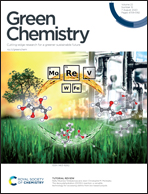Hydrothermal carbonization of activated sewage sludge over ammonia-treated Fenton sludge to produce hydrochar for clean fuel use†
Abstract
Fenton sludge was hydrothermally treated with ammonia (ATFS) and used as a catalyst for the hydrothermal carbonization (HTC) of activated sewage sludge (ASS) to produce a hydrochar for fuel use. HTC reactions were performed at temperatures varying from 200 to 260 °C for 1 h with or without the addition of 7.6 wt% ATFS. The ASS concentration was kept constant at 10 wt%. Lower hydrochar yield was always observed at higher temperatures as more organic matter stayed in the aqueous phase post reaction. With the addition of ATFS, the hydrochar yield was increased by 7–18% compared with that without catalyst at different temperatures. Adsorption and acidic sites of nano γ-Fe2O3 probably played a key role during the HTC process. All hydrochars had lower N content as compared to ASS, particularly hydrochars produced with the addition of ATFS. More than half of the energy in ASS was recovered in the hydrochar. ATFS, which stayed with the hydrochar after ASS HTC, favored hydrochar generation by reducing its combustion activation energy. ATFS was a promising catalyst for the production of clean hydrochar via HTC of ASS.



 Please wait while we load your content...
Please wait while we load your content...